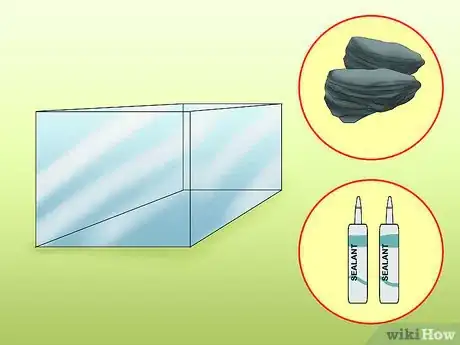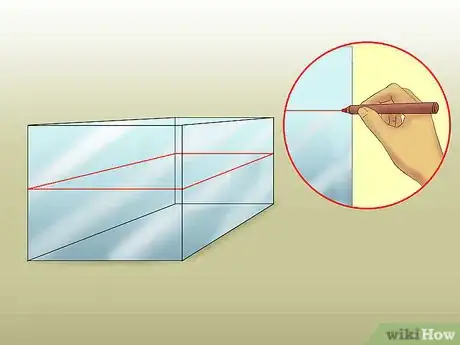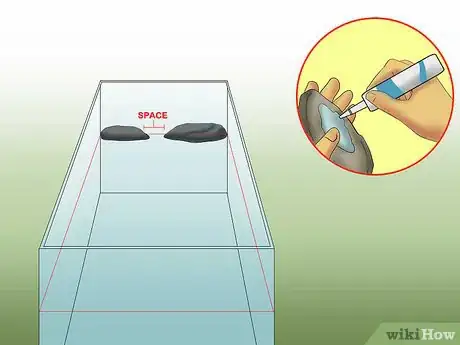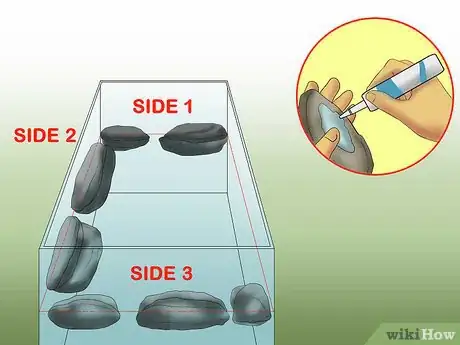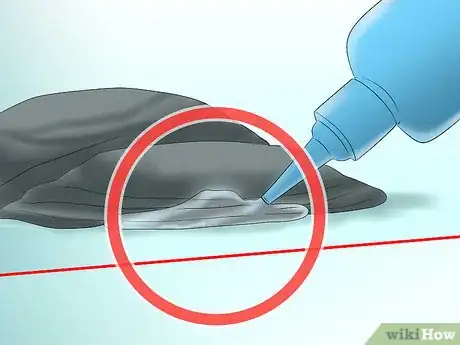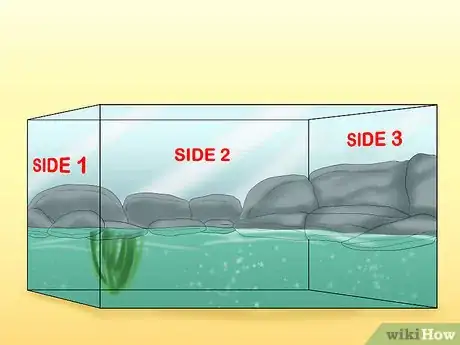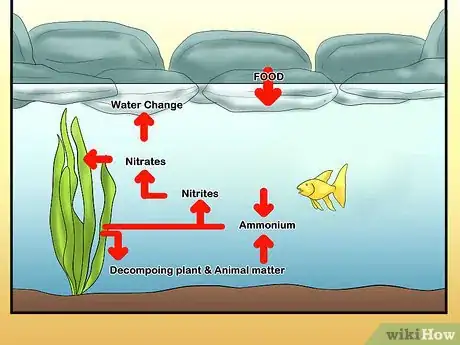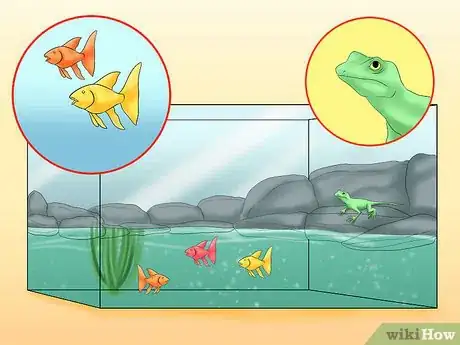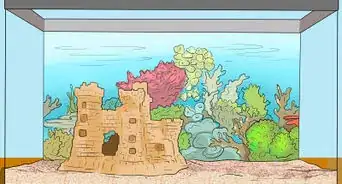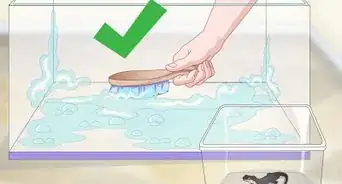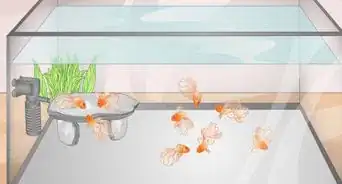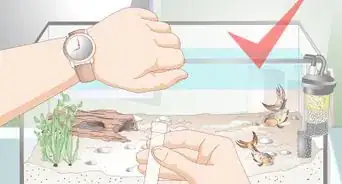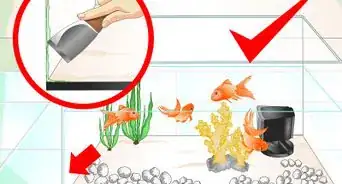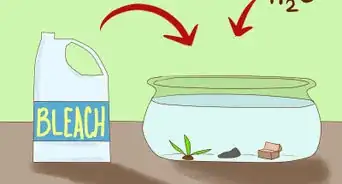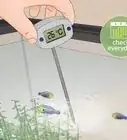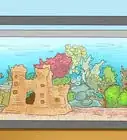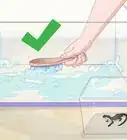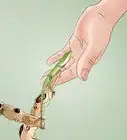X
wikiHow is a “wiki,” similar to Wikipedia, which means that many of our articles are co-written by multiple authors. To create this article, 38 people, some anonymous, worked to edit and improve it over time.
This article has been viewed 231,571 times.
Learn more...
Create an educational fish tank that is stimulating for lizards and amphibians without a messy and unhealthy dirt substrate. More surface area for running can be created.
Steps
-
1
-
2Draw a removable straight line all the way around the tank on the outside glass 1/3rd of the way from the top. (2/3rds of tank will be water, 1/3rd is lizard habitat.)Advertisement
-
3Set the tank on its side with the top facing you and glue pieces of slate on the inside of tank on your line. Each piece must be level with each other and spaced so that a lizard can hop or swim from one to another, but not too close (so the lizard can get out of the water). The slate will act as a beach.
-
4Wait for the sealant to dry, then glue more slates on the remaining 3 sides of tank.[2]
-
5After the glue is dry, use more sealant to strengthen the bond between glass and rock.
-
6When the glue dries, and the tank is set up for fish, fill tank up to the main slates.
-
7Cycle the tank. This step is important to the health of the fish.[3]
-
8Buy community tropical fish (small ones that won't drag lizards under) and lizards that are comfortable with water and won't eat your fish.
Advertisement
Community Q&A
-
QuestionCan long tailed lizards swim?
 Community AnswerYes. They fold in their legs and swim like a snake by twisting their body in a ribbon like motion.
Community AnswerYes. They fold in their legs and swim like a snake by twisting their body in a ribbon like motion. -
QuestionCan guppies and green anoles live together?
 Community AnswerYes, but get full grown guppies, as the anole will eat the small ones. Make the tank half land and half water.
Community AnswerYes, but get full grown guppies, as the anole will eat the small ones. Make the tank half land and half water. -
QuestionWhich fish and lizards can be kept together?
 Community AnswerGuppies can be kept with green anoles, brown anoles, and other small lizards in a 10-40+ gallon tank. Chinese water dragons and any other lizards can be kept in a 55-gallon tank. Guppies or other medium-sized tropical fish are okay, just make sure they're full grown (no babies, as the lizard may eat them).
Community AnswerGuppies can be kept with green anoles, brown anoles, and other small lizards in a 10-40+ gallon tank. Chinese water dragons and any other lizards can be kept in a 55-gallon tank. Guppies or other medium-sized tropical fish are okay, just make sure they're full grown (no babies, as the lizard may eat them).
Advertisement
Warnings
- Lizard waste can carry disease.⧼thumbs_response⧽
- Some lizards will not thrive in this environment, as they need room to run around, catch their prey, and not have the constant threat of falling into the water in their sleep. Make sure you get the right type of lizard- an aquatic one that would be best suited for this- or get a turtle/amphibian.⧼thumbs_response⧽
- If slates are too close, they can create a 'pinch-point', where tails can get stuck. However, some species of lizard can live without their tail.⧼thumbs_response⧽
- Keep an eye on all new lizards.⧼thumbs_response⧽
- It would be a really good idea for the lizard keeper to thoroughly investigate the needs of the particular lizard they are wanting to get before doing anything like this.⧼thumbs_response⧽
- It would be a good idea to read up on "Species Mixing Disasters" before putting lizards with fish in such a way. It might not be an issue in a 70 gallon (265.0 L) or larger aquarium with very large land area.⧼thumbs_response⧽
- A secure top is a must.⧼thumbs_response⧽
- Make sure reptile heater does not fall in water.⧼thumbs_response⧽
- The fish tank heater must be the submersible type.⧼thumbs_response⧽
- This setup can cause stress to lizards. Most lizards do not hang onto things very tightly. Some lizards need an arid desert environment with about 20% humidity.⧼thumbs_response⧽
Advertisement
Things You'll Need
- Fish tank, the larger the better.
- 2 large tubes of aquarium glue.
- 20 pieces of slate or more (depends on tank size), each piece having a flat edge about 1⁄2 inch (1.3 cm) thick.
- Tank hood with UV (special for reptiles) fluorescent bulb.
- Gravel, thermometer, underwater heater and filter (not requiring a full tank).
- Knowledge of lizards, amphibians and fish.
- Reptile heater.
References
About This Article
Advertisement
